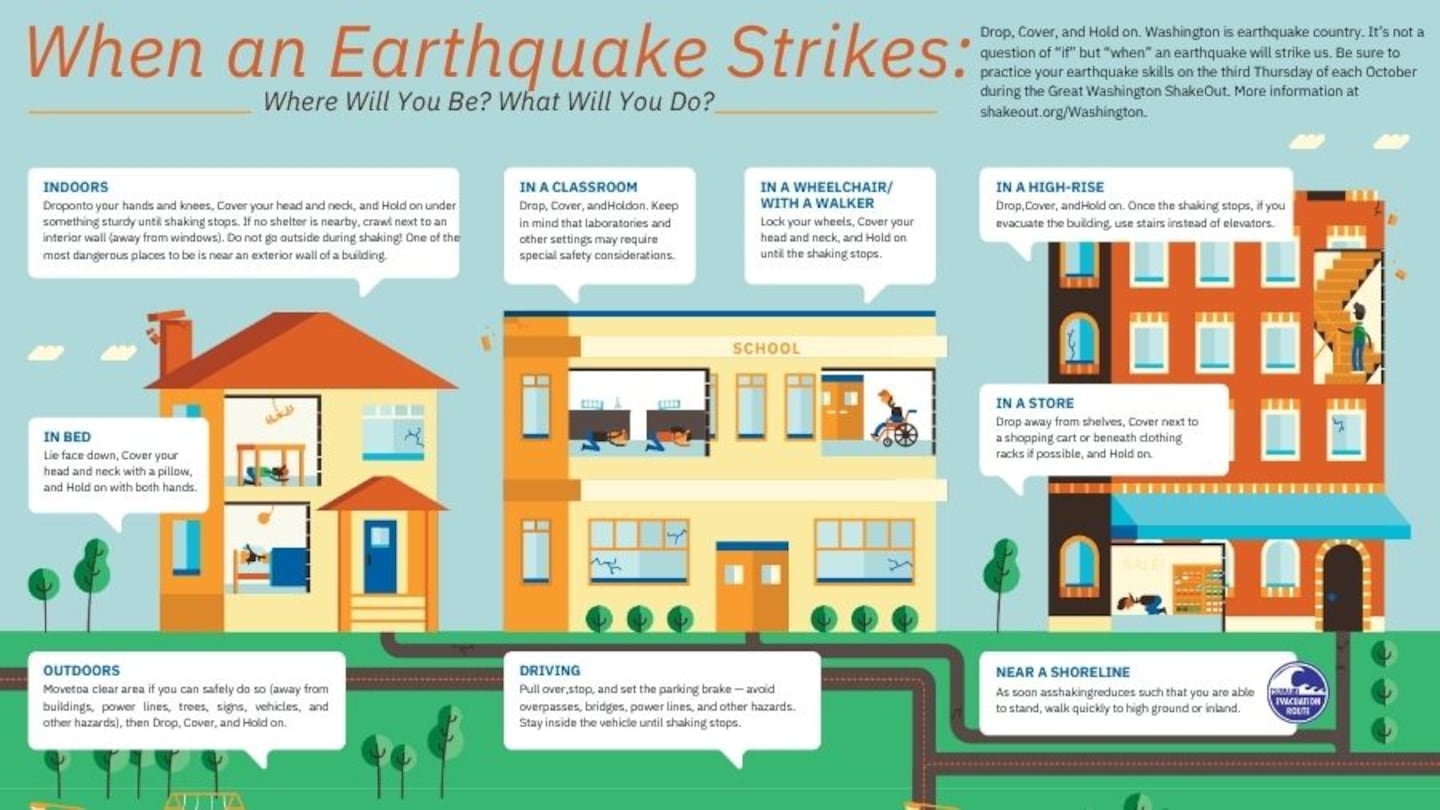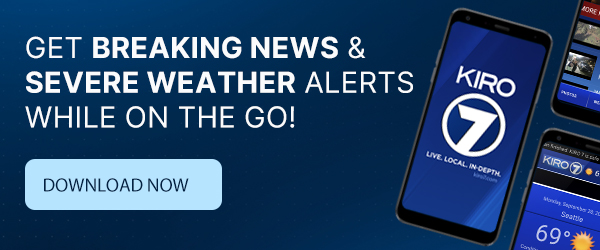This story was originally published on MyNorthwest.com
Ready to participate in the Great Shakeout on Thursday, Oct. 16, at 10:16 a.m.? More than 1.5 million people in Washington have already registered to do so. You can join the fun drill by going to the Washington State Great Shakeout Registration Page. Registration will take just a few minutes.
Those who already have and can register include families, businesses, schools, health care facilities, faith-based organizations, neighborhood groups, and more.
The Great Shakeout is not just a Washington event, but a worldwide event. Millions around the globe will participate by practicing the “drop, cover, and hold” technique under a desk, table, or other sturdy items in case of an earthquake. In recent years, many have had fun at work, school, or elsewhere by taking photos and videos while under a table or desk and posting them on social media.
Where to hear the Great Shakeout
The drill will kick off when the Emergency Alert System (EAS) is activated at 10:16 a.m. Thursday on the National Weather Service’s NOAA Weather Radio network statewide, and aired by all radio and TV broadcasters and cable systems, and that includes KIRO Newsradio, Seattle Sports, and Seattle Red.
Recent smaller earthquakes around Vancouver Island and across western Washington serve as reminders that Washington is earthquake country, the second-most threatened state in the nation behind California. There are many earthquake faults around the region, including the Tacoma fault, the Seattle fault, and the South Whidbey Island fault, which geological history has shown can all produce 7.0 magnitude quakes or greater.
Then there is the Cascadia Subduction Zone, approximately 100 miles off the coast, that stretches from northern Vancouver Island to northern California. The last time that the earthquake zone “let go” was on January 26, 1700, with an estimated 9.0 magnitude tremor. Shaking lasted for up to 5 minutes and generated a Pacific-wide tsunami, with tsunami waves inundating coastal regions and extending into western Washington’s interior waters.
Geologists indicate this earthquake source releases pressure about every 300 to 500 years, meaning it could occur at any time now. This subduction zone is similar to others around the Pacific Ocean basin, including the one off the coast of Japan, which produced a major earthquake and tsunami in March 2011, and another recently off eastern Russia.
“People living on or visiting the coastal areas where we have tsunami sirens should know that as close to 10:16 a.m. as possible, we will be testing the sirens with the full wailing capability. This is supposed to happen, so do not call 911,” Hollie Stark of Washington State Emergency Management said.
There are more than 100 outdoor siren systems along the outer coast, the Strait of Juan de Fuca, and in the North Sound region, including Anacortes, Edmonds, and the Everett waterfront.
Potential tsunamis after an earthquake
When a big earthquake occurs, it is also essential to know if you are in a low-lying coastal tsunami inundation hazard zone. Ground shaking may be the only warning before tsunami waves arrive. Knowing in advance evacuation routes and where to move to higher ground, including vertical evacuation in multi-story buildings or towers, is imperative. Many outer Washington coastal schools will also practice their tsunami evacuation plans following the earthquake drill.
“Earthquakes have happened here in the past, and they will happen again,” Stark said. “If you only think about earthquake protective actions once a year, ShakeOut is the time to do it, while we are not in an actual emergency. Plus, you can make your drill fun!”
Stark noted, “If you ask yourself this question, we hope it helps you think of some steps you can take right now to make your home, work, and life a bit safer from earthquakes.”
Earthquakes are no-notice events. Also, use the Shakealert app for quakes that are further away and offer a short time to prepare.
This year’s Great Shakeout earthquake drill also focuses on being prepared and safe wherever you may be at the time an earthquake occurs.
For instance, people spend about a third of their lives asleep. If you are in bed, stay there and cover your head with a pillow until the shaking stops. Have a pair of hard-soled shoes under the bed to put on after the quake. Many injuries occur when walking in the dark with bare feet. Also consider a flashlight, gloves, light sticks, and even a hard hat under your bed. Here is a helpful short video on earthquake safety while in bed.
Daily lives also occur at work, school, shopping, or while traveling. Schools use this event as their October monthly emergency drill.
What to do when an earthquake strikes
It is crucial to consider earthquake safety actions wherever you may be when a quake strikes. Communication with loved ones and work staff is also important. Phone systems will likely be overwhelmed in the wake of an earthquake.
Having a backup communication plan can be critical. The Great Shakeout drill offers the chance to practice your backup communication plan. Know in advance how and who to reach in case phone and power systems go out of service, which will be quite likely.
Stark added, following the Great Shakeout drill, “Do a home hazard hunt. Check with your students and their schools’ reunification plans, sign up for local alerts, and learn more about earthquake early warning at mil.wa.gov/alerts.”
To register for the Great Shakeout Washington and learn more information about this annual earthquake drill and how to better prepare your home, workplace, school, and more for earthquakes, visit ShakeOut.org. Thursday morning’s Great Shakeout drill will offer the opportunity to practice dropping, covering, and holding on under a sturdy structure for a minute, and have fun doing it!
As Stark highlighted, “Remember! You can survive, if you get prepared!” Register today at shakeout.org/washington
Ted Buehner is the KIRO Newsradio meteorologist. Follow him on X and Bluesky. Read more of his stories here.
©2025 Cox Media Group







